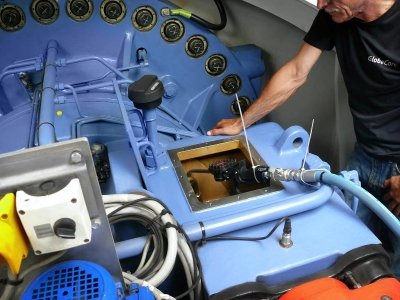Proper and long term functioning of the Gearbox is very critical and depends mainly on the
quality of oil cleanliness. Gearbox failures are primarily a result of oil contamination due to
ingress of dust, metallic wear on account of friction, water contamination resulting in change
of oil parameters, oil degradation, and excess vibrations leading to probable surface cracks,
misalignment of pump+motor shaft. Wind turbines being placed in remote locations, regular
monitoring of oil condition assumes importance. Choosing the right amount to invest in
contamination control to optimize your return on investment should be the goal. The ideal ISO
Cleanliness Code for oil in gearbox is 16/15/12 and water content < 500 ppm. This ensures a
very long life of the gearbox which is typically 15 years to 20 years. The ISO Code 16/15/12
means the following:
In a wind-turbine gearbox, the most common gear-oil viscosity is ISO 320 which is calculated
at 40°C and reported as centistokes (cst). If the viscosity decreases beyond permissible limit,
the oil is shearing and there is potential for reduced oil-film thickness, resulting in increased
wear. If the viscosity increases, it may be due to oxidation by-products which can be
associated with oil degradation and shortened filter and oil life.
It is a well-known fact that it costs at least 10 times more to remove a gram of dirt than it would
to exclude it in the first place Even in very tiny amount, contaminants can increase operating
costs associated with maintenance expenses or gearbox replacement. The main
contaminants affecting oil and gearbox life are water, wear particles, and dirt. Along with
additive depletion, water can cause filter plugging, sludge formation, reduced oil-film
thickness, and be difficult and expensive to remove.
As a general rule, it is accepted that water is detrimental in wind-turbine gear oil. A 0.05%
presence of water in oil equates to 58% reduction in bearing life. However, filtration from 10
micron to 3 micron will increase bearing life by 50%. These allowable presence of water in oil
limit ( ppm ) varies with acceptable levels from 0 to <500 ppm.
Each oil type has a different starting point for total acid number (TAN) which is directly
associated with additive content. A general rule is to condemn the oil when the TAN increases
more than two points higher than the initial TAN. In this case it is best to consult your oil
supplier for the new oil-TAN value and used oil-condemning limit. If the TAN increases and
exceeds the condemning limit it may be an indication the oil is turning corrosive and may
contribute to depleted additives and increased wear.


